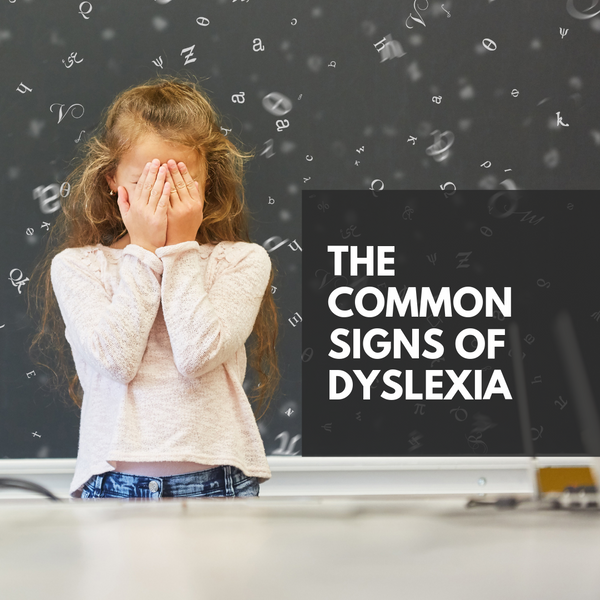The Common Signs of Dyslexia

Dyslexia is a neurobiological based learning difference where individuals have difficulties with word decoding, word recognition and spelling. These difficulties are present despite adequate intelligence, conventional education and motivation. Those with dyslexia often go undiagnosed for years, with students struggling to receive the extra support and guidance that they require. This can lead to children struggling to keep up with their peers, and social problems such as low self-esteem, behavior problems, anxiety and aggression, and withdrawal from parents, friends and teachers. This can prevent a child from reaching their potential, and can have long-term educational, social and economic consequences.
Although there is no cure to dyslexia, early assessment and intervention can have a major difference in helping with reading comprehension, vocabulary growth, and a child’s own understanding of their learning difference.
Signs of dyslexia can be tricky to detect, especially in the early years. For preschoolers, dyslexia can be detected in the relative academic level of a child with other children of the same age.

Preschool
Reading, Spelling and Oral Skills:
- May talk later than most children.
- Difficulty forming words correctly, such as reversing sounds in words or confusing words that sound alike. E.g. Mawn lower for lawn mower.
- Slow to learn new words.
- Problems remembering or naming letters, days of the week, shape, numbers, colors, and his or her name.
- May be unable to recall the right word. Often has difficulty blending sounds to make words, and separating sounds in words.
- May have difficulty with rhyming.
Memory and Cognition:
- May have difficulty telling or re-telling a story in the correct sequence.
Motor Skills:
- May struggle to follow multi-step directions or routines.
- Trouble with writing or copying: Pencil grip is unusual, and handwriting varies or is illegible.
- Clumsy, uncoordinated, poor at ball or team sports.
- Prone to motion-sickness.
- Can be ambidextrous, and often confuses left/right, and over/under.
Behavior and Development:
- May have had unusually early or late developmental stages such as talking, crawling, walking, typing shoes.
- Confusion and emotional stress have a dramatic influence on mistakes and symptoms.
From kindergarten through to fourth grade, recognizing dyslexia is still difficult, but there are more opportunities to detect delays in reading and comprehension. A classroom teacher might even be able to confirm if your child is falling behind, but it is always good to check with a doctor or a qualified testing examiner if you do recognize some signs.

School Age
Reading, Spelling and Oral Skills:
- Reading well below the expected level for age.
- Has difficulty reading single words in isolation (decoding).
- Problems processing and understanding what he or she hears.
- Confuses small words such as at/to, said/and, does/goes.
- Makes consistent reading and spelling errors:
- Letter reversals: d for b – dog for bog
- Word reversals: tip for put
- Inversions: m and w, u and n
- Transpositions: felt and left
- Substitutions: House and home
- Relies heavily on memorizing without understanding.
Math and Time Management:
- May confuse arithmetic signs (+ - x = )
- May have difficulty telling the time, and managing time.
- Dependence on finger counting.
- Difficulty counting objects and dealing with money.
- Cannot grasp algebra or higher math.
Memory and Cognition:
- Poor memory for sequences, facts, and information that has not been experienced.
- Thinks predominantly with images and feeling, rather than sounds or words.
Motor Skills:
- Often uses an awkward pencil grip.
- Poor coordination
Behavior and Development:
- Avoids activities that involve reading, spelling, and writing.
- May withdraw from educational situations.
- May lose motivation for academic pursuits.
- May have disciplinary issues. They might interrupt academic work and ready time, or become reserved and quiet.

Recognizing these signs is the first step in helping your child gain their sense of confidence and pride in their academic study. There are many educational specialists who are trained to help children with dyslexia, as they have methods in place to help your child:
- Learn and recognize phonemes (the smallest sounds that make up words) – e.g. /c/a/t
- Build phonemic awareness (letters and strings of letters that represent sounds and words).
- Comprehend what he or she is reading.
- Increase reading accuracy, speed and expression.
- Build a strong vocabulary of words.
There are many ways in which the home environment can also help overcome a child’s learning disabilities. Parents will need to spend extra time with their child, helping them to develop these decoding techniques, cognitive abilities, and writing skills. There are many resources that parents can use to help them in their teaching. Junior Learning, for instance, has developed a range of interactive and engaging materials that enable kids with a variety of learning disabilities and special needs to construct words and sentences, improve their ability to retain information, and to read and write stories. Dr. Duncan Milne, an educational neuroscientist, has developed these learning resources so all children can find their love for learning.
For more information, Duncan Milne’s book, “The Miraculous Dyslexic Brain” provides an excellent explanation for how the dyslexic student learns, and the specific resources that can help the dyslexic brain process information.
Comments
0 Comments
Leave a Comment